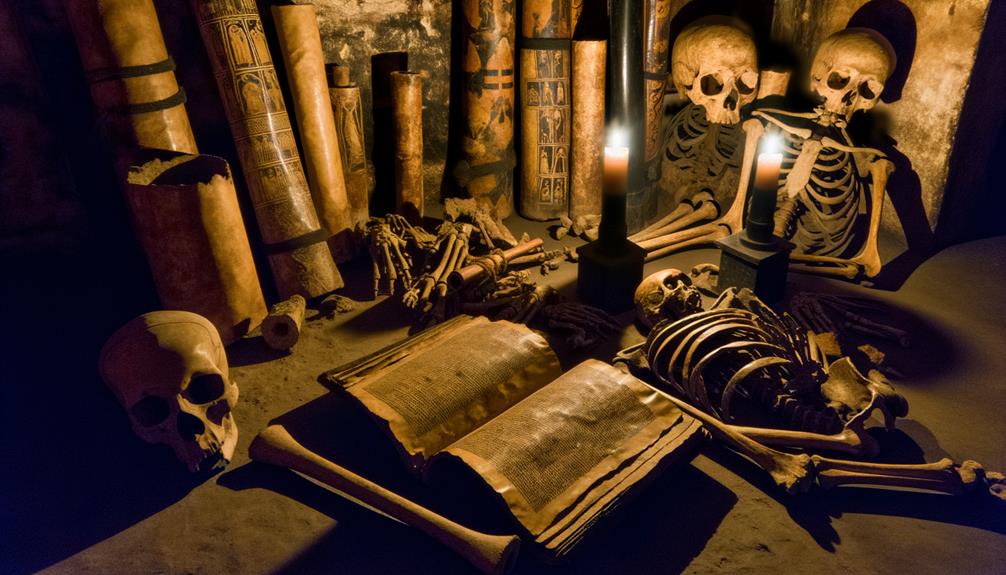Bones in the Bible Meaning: Strength, Resurrection
In the Bible, bones symbolize a range of profound theological and existential concepts. They underpin narratives of divine creation and relational unity, as seen in Eve’s origin from Adam’s rib.
Joseph’s bones signify the continuity of God’s covenantal promises. The vision of the Valley of Dry Bones illustrates restoration and hope through divine intervention.
Jesus’s resurrection contends with both theological affirmation and historical debate about physical remnants. Symbolically, bones encapsulate mortality, purity, and divine fidelity, often serving as metaphors for deeper spiritual truths and communal memories.
The study of bones in biblical texts reveals rich layers of meaning and communal heritage.

Bones in the Bible Meaning: Symbolism and Spiritual Messages
| Aspect | Details |
|---|---|
| Definition | Bones symbolize the physical and spiritual structure of life |
| Key Bible Reference | Ezekiel’s vision of dry bones (Ezekiel 37:1-14) |
| Symbolic Meaning | Resurrection, restoration, inner strength, and God’s power over death |
| Spiritual Insight | God can bring life to what is spiritually dead |
| Moral Lesson | Faith can revive even the driest, most lifeless parts of our existence |
Creation of Eve

In the biblical narrative, the creation of Eve from Adam’s rib serves as a foundational moment that underscores the profound theological and symbolic significance of bones in Judeo-Christian thought.
This act, described in Genesis 2:21-23, symbolizes the intrinsic connection and equality between man and woman. The use of a rib, rather than another body part, signifies protection and intimacy, as the rib protects essential organs.
Theologically, it highlights God’s intent for relational unity and mutual dependence. Symbolically, it portrays the notion of shared essence and origin, reinforcing the concept of human interconnectedness.
Consequently, the creation of Eve from Adam’s bone is not merely a physical act but a profound statement on the divine design of human relationships and community.
Joseph’s Bones

Although often overlooked, the narrative of Joseph’s bones serves as an essential theological and symbolic element in the biblical text, reflecting themes of faith, promise, and the enduring legacy of God’s covenant.
Joseph, foreseeing the eventual exodus of the Israelites from Egypt, requested that his remains be carried to the Promised Land (Genesis 50:25). This act underscores the unwavering faith in God’s promise to Abraham.
The fulfillment of this request, as recorded in Exodus 13:19 and Joshua 24:32, symbolizes the continuity and reliability of God’s covenantal promises.
Joseph’s bones become a tangible link between the patriarchal past and the future realization of divine pledges, portraying a profound sense of spiritual continuity and divine fidelity in Israel’s collective memory.
Valley of Dry Bones

The vision of the Valley of Dry Bones, found in Ezekiel 37:1-14, serves as a powerful metaphor for the restoration of Israel through divine intervention and the reanimation of hope among a despondent people.
In this prophetic vision, Ezekiel witnesses a valley filled with desiccated bones, symbolizing the spiritual and national death of Israel during the Babylonian exile.
God’s command to prophesy over the bones results in their miraculous reassembly and reanimation, illustrating the transformative power of divine word and spirit.
This allegory underscores the theme of resurrection and renewal, emphasizing that even in the most hopeless circumstances, divine intervention can restore life and purpose.
This passage profoundly encapsulates the eschatological promise of redemption.
Bones of Jesus

Debate surrounding the bones of Jesus often explores theological, historical, and archaeological domains, raising significant questions about the nature of his resurrection and the implications for Christian doctrine.
Theologically, the resurrection is central to Christian belief, asserting Christ’s bodily resurrection and ascension, hence the absence of physical remains.
Historically, claims such as the discovery of the Talpiot Tomb in 1980 have sparked controversy, suggesting the possibility of Jesus’ family burial site. However, these claims lack conclusive evidence and remain highly contested within scholarly circles.
Archaeologically, no verified remains of Jesus have been discovered, aligning with traditional Christian teachings.
This ongoing debate continues to challenge and refine the understanding of one of Christianity’s core tenets.
Symbolism of Bones

Bones in biblical literature often carry profound symbolic meanings, reflecting themes of mortality, divine intervention, and covenantal promises.
For instance, in Ezekiel 37, the vision of dry bones represents the restoration of Israel, symbolizing hope and renewal through divine power.
Similarly, the unbroken bones of the Paschal Lamb in Exodus 12:46 signify purity and the integrity of God’s covenant.
Additionally, bones can denote the essence of human existence, as seen in Genesis 2:23, where Adam acknowledges Eve as ‘bone of my bones.’ This underscores the intimate connection and shared nature of humanity.
Consequently, bones in biblical texts are not mere physical elements but serve as rich symbols that convey deeper theological and existential truths.
Conclusion
The examination of bones in the Bible reveals their profound theological and symbolic significance, from the creation of Eve from Adam’s rib to the resurrection imagery in the Valley of Dry Bones.
Significantly, the preservation of Joseph’s bones underscores the enduring importance of legacy and covenant.
According to biblical accounts, bones are mentioned over 100 times, emphasizing their recurrent role in narrative and metaphorical contexts.
This frequency illustrates the deep intertwining of physical and spiritual themes within the biblical canon.






